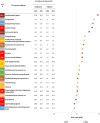Drug-utilisation profiles and COVID-19
- PMID: 33903671
- PMCID: PMC8076316
- DOI: 10.1038/s41598-021-88398-y
Drug-utilisation profiles and COVID-19
Abstract
Coronavirus disease 2019 (COVID-19) has substantially challenged healthcare systems worldwide. By investigating population characteristics and prescribing profiles, it is possible to generate hypotheses about the associations between specific drug-utilisation profiles and susceptibility to COVID-19 infection. A retrospective drug-utilisation study was carried out using routinely collected information from a healthcare database in Campania (Southern Italy). We aimed to discover the prevalence of drug utilisation (monotherapy and polytherapy) in COVID-19 versus non-COVID-19 patients in Campania (~ 6 million inhabitants). The study cohort comprised 1532 individuals who tested positive for COVID-19. Drugs were grouped according to the Anatomical Therapeutic Chemical (ATC) classification system. We noted higher prevalence rates of the use of drugs in the ATC categories C01, B01 and M04, which was probably linked to related comorbidities (i.e., cardiovascular and metabolic). Nevertheless, the prevalence of the use of drugs acting on the renin-angiotensin system, such as antihypertensive drugs, was not higher in COVID-19 patients than in non-COVID-19 patients after adjustments for age and sex. These results highlight the need for further case-control studies to define the effects of medications and comorbidities on susceptibility to and associated mortality from COVID-19.
Conflict of interest statement
The authors declare no competing interests.
Figures



References
-
- World Health Organization. Coronavirus disease 2019 (COVID-19), Situation Report—95. www.who.int/docs/default-source/coronaviruse/situation-reports/20200424-.... Accessed on 4 April 2020.
Publication types
MeSH terms
Substances
LinkOut - more resources
Full Text Sources
Research Materials

